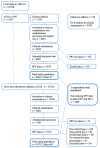A Childhood Farm Environment Protects from Allergic Sensitization until Middle Age but Not from New-Onset Sensitization in Adulthood: A 15 Year Longitudinal Study
- PMID: 34281015
- PMCID: PMC8297149
- DOI: 10.3390/ijerph18137078
A Childhood Farm Environment Protects from Allergic Sensitization until Middle Age but Not from New-Onset Sensitization in Adulthood: A 15 Year Longitudinal Study
Abstract
Data are insufficient on the protective effect of a farm environment in childhood regarding sensitization in middle age and new-onset sensitization in adulthood. A skin prick test (SPT) and questionnaire data from the Northern Finland Birth Cohort 1966 study (NFBC66) were used to investigate sensitization at age 46 years related to childhood living environment. A subpopulation of 3409 participants was analyzed to study factors related to new-onset sensitization between ages of 31 and 46 years. Data on complete SPTs were available for 5373 cohort members at age 46. Professional farming by parents (odds ratio (OR) 0.54; 95% confidence interval (CI) 0.43-0.68) and keeping of farm animals (OR 0.53; 95% CI 0.43-0.66) in infancy were associated with a lower risk of sensitization at age 46. Sensitization (OR 0.58; 95% CI 0.47-0.72) and polysensitization (OR 0.43; 95% CI 0.32-0.57) were less common in those who lived in a rural area in infancy compared to a city area. The childhood living environment had no effect on new-onset sensitization between ages 31 and 46. We conclude that living on a farm or in a rural environment in childhood had a protective effect on sensitization even in middle age, but these factors did not protect from new-onset sensitization in adults.
Keywords: adulthood; childhood; farm; new onset; sensitization.
Conflict of interest statement
The authors have no conflict of interest to declare.
Figures
Similar articles
-
Farm Environment During Pregnancy and Childhood and Polysensitization at the Age of 31: Prospective Birth Cohort Study in Finland.J Investig Allergol Clin Immunol. 2021 Feb 17;31(1):44-51. doi: 10.18176/jiaci.0455. Epub 2019 Oct 7. J Investig Allergol Clin Immunol. 2021. PMID: 31589143
-
Farming environment and prevalence of atopy at age 31: prospective birth cohort study in Finland.Clin Exp Allergy. 2011 Jul;41(7):987-93. doi: 10.1111/j.1365-2222.2011.03777.x. Epub 2011 May 16. Clin Exp Allergy. 2011. PMID: 21575087
-
Parental farming protects children against atopy: longitudinal evidence involving skin prick tests.Clin Exp Allergy. 2002 Aug;32(8):1155-9. doi: 10.1046/j.1365-2745.2002.01448.x. Clin Exp Allergy. 2002. PMID: 12190651
-
The Danish urban-rural gradient of allergic sensitization and disease in adults.Clin Exp Allergy. 2016 Jan;46(1):103-11. doi: 10.1111/cea.12583. Clin Exp Allergy. 2016. PMID: 26096697
-
Low prevalence of atopy in young Danish farmers and farming students born and raised on a farm.Clin Exp Allergy. 2002 Feb;32(2):247-53. doi: 10.1046/j.1365-2222.2002.01310.x. Clin Exp Allergy. 2002. PMID: 11929489
Cited by
-
Influence of Childhood Exposure to a Farming Environment on Age at Asthma Diagnosis in a Population-Based Study.J Asthma Allergy. 2021 Sep 7;14:1081-1091. doi: 10.2147/JAA.S323504. eCollection 2021. J Asthma Allergy. 2021. PMID: 34522104 Free PMC article.
-
The Imprint of Exposome on the Development of Atopic Dermatitis across the Lifespan: A Narrative Review.J Clin Med. 2023 Mar 11;12(6):2180. doi: 10.3390/jcm12062180. J Clin Med. 2023. PMID: 36983182 Free PMC article. Review.
References
-
- Haarala A.K., Sinikumpu S.-P., Vaaramo E., Jokelainen J., Timonen M., Auvinen J., Pekkanen J., Lampi J., Huilaja L. Incidence and remission of aeroallergen sensitization in adults in Northern Finland: 15 years longitudinal study. Sci. Rep. 2021;11:4249. doi: 10.1038/s41598-021-83326-6. - DOI - PMC - PubMed
-
- Yabuhara A., Macaubas C., Prescott S.L., Venaille T.J., Holt B.J., Habre W., Sly P., Holt P.G. TH2-polarized immunological memory to inhalant allergens in atopics is established during infancy and early childhood. Clin. Exp. Allergy. 1997;27:1261–1269. doi: 10.1111/j.1365-2222.1997.tb01170.x. - DOI - PubMed
Publication types
MeSH terms
Substances
LinkOut - more resources
Full Text Sources
Medical


